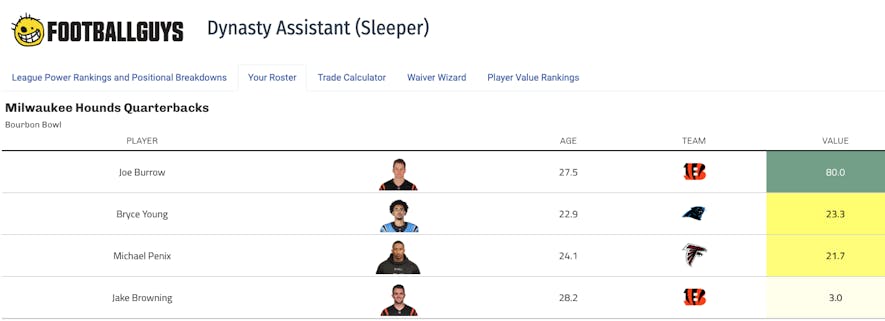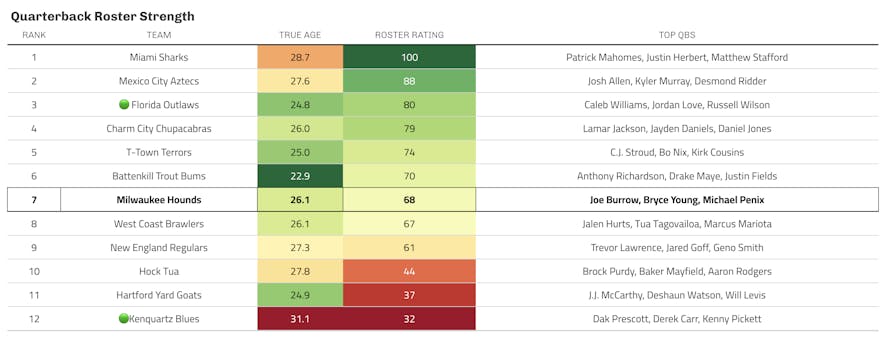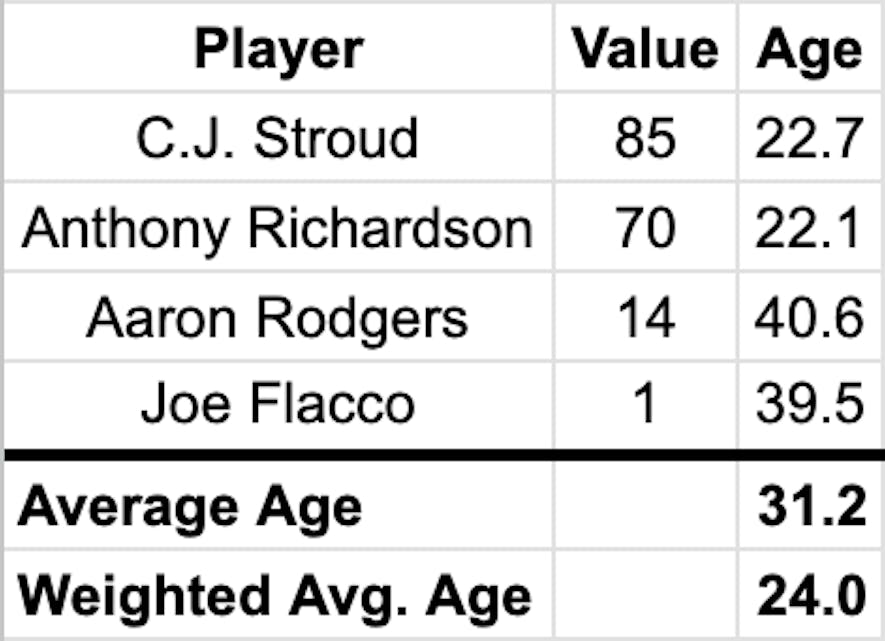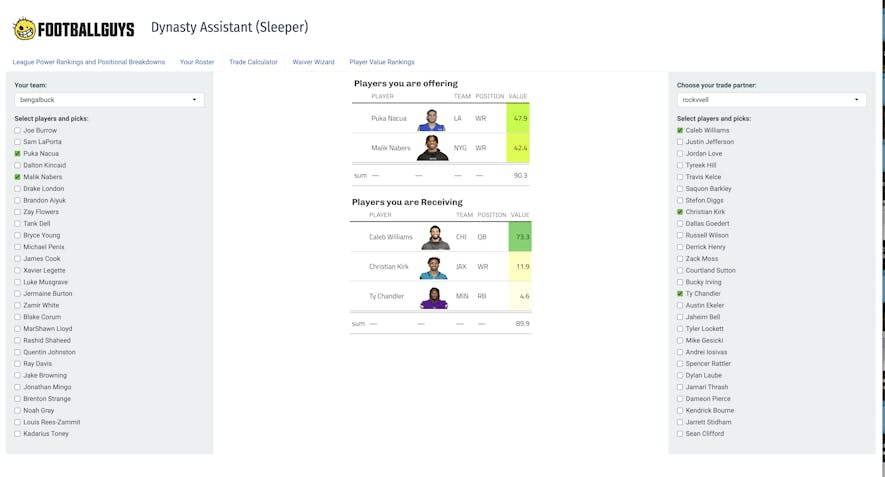This week's Dynasty Data article will preview a new tool called the Dynasty Assistant. The article will be broken down into the following sections:
- Is the Dynasty Assistant for you?
- Instructions
- League Power Rankings, Positional Power Rankings, and Your Roster.
- True Age
- Trade Calculator
- Waiver Wizard
- Positional Value Adjustments
1. Is the Dynasty Assistant for you?
- Are you in a dynasty league on Sleeper?
- Has that league already completed the startup draft?
- Are you curious how your roster stacks up against the rest of your league?
- Do you want a dynasty trade calculator with player values custom to your league and dynasty waiver wire recommendations based upon those custom player values?
If so, the Dynasty Assistant (Sleeper) tool is for you.
Other Footballguys tools will better serve those in non-dynasty leagues or dynasty leagues hosted on other sites.
2. Instructions
Instructions for getting started with the tool.
- Enter your Sleeper username. Please note: this is case sensitive, so make sure to capitalize any letters that are capitals in your Sleeper name.
- Press Load Leagues
- This will automatically load a list of all of your leagues. Select the dynasty league you want to explore from the "Select League" dropdown menu.
- Press Start Assistant
That is all there is to it. The assistant should load within seconds of pressing the "Start Assistant" button.
3. League Power Ratings, Positional Power Ratings, and Your Roster
Once you hit the Start Assistant button, you will see your League Power Ratings, which will look like this:
Your team will be in bold. Each dynasty roster is ranked by how valuable the roster is overall.
Power Rating
The league's best roster will automatically have a Power Rating of 100. In this case, the Milwaukee Hounds have the most valuable roster in the league (total value of 543) and a Power Rating of 100. The second-best roster is the Mexico City Aztecs (total value of 445). The Aztecs' power rating of 82 reflects how close the roster is to the top team in the league (445 divided by 543 equals .82).
If the best roster in your league is worth 500 value points and your roster is worth 250, your roster would be precisely 50% as valuable as the top roster in your league, and you would have a Power Rating of 50.
What do the numbers mean?
In the table above, you will notice each team has a number value listed for each position. For example, the Hounds quarterbacks are worth 128 value points. What does that number mean?
The Dynasty Assistant automatically calculates the dynasty value of every player in the league on a 0 to 100 scale. To see the value of each of your players, you can look at the Your Roster tab. Here is what the top of the tab looks like for the Hounds:
Adding up the individual values of each of the four quarterbacks on the Hounds roster gives us a total of 128 points worth of dynasty value. This is the exact number in the main Power Ratings table. The same simple addition of each player's value is performed for every position group on every team dynasty team in your league. Those numbers will be seen in the Overall League Power Ratings table at the top of the Dynasty Assistant.
How do my league Power Ratings help me?
Aside from being a fun measuring stick to see how you stack up against your league mates, the power ratings will help you identify your strengths and weaknesses and the teams that might match up best for a potential trade.
For example, if we scroll back up to the Power Ratings above, we can see that the Hounds are extremely strong at wide receiver and tight end but mediocre at running back. It makes sense for the Hounds to deal from a position of strength to upgrade at running back. A glance at the table reveals that the Yard Goats have the most valuable collection of running backs in the league but have major weaknesses at both wide receiver and tight end. We have quickly identified a potential trade partner and can hop over to the Trade Calculator tab to craft a reasonable offer.
Positional Power Ratings
The main tab also includes power ratings for each position. For example, here is the table showing quarterback power ratings in our example league:
As with the overall league rankings, the best quarterback roster automatically earns a positional power rating score of 100. Each other team's roster rating is relative to the top roster. The positional ratings also include the top players on each team's roster at the position. It is a great way to quickly see which teams own which players and is another valuable tool for formulating potential trade ideas. The Hounds could use a short-term upgrade at QB2. The Miami Sharks have a pair of high-end quarterbacks and Matthew Stafford sitting on their bench as the QB3. Stafford is an obvious trade target based on the Hounds and Sharks' roster constructions.
4. True Age
You may have noticed that each of the Power Ratings tables has a column True Age. This is the weighted average of each dynasty team's players. Why are we using a weighted (by dynasty value) average instead of just a simple average, and why is a weighted average a better metric? Let's look at an example. Imagine these are the four quarterbacks on your dynasty roster in a Superflex league:
If we calculate a simple average of the quarterbacks' ages (31.2), we are left with the impression that this roster has aging quarterbacks and may need to aggressively add young blood at the position. However, this number is obviously skewed by the age of the backups. The two most important and valuable quarterbacks on this roster (Stroud and Richardson) are extremely young. Calculating a weighted average age (True Age) gives us much better insight into how youthful this quarterback group is.
5. Trade Calculator
In addition to helping you see how your roster stacks up against the rest of the league, the Dynasty Assistant also includes a trade calculator. It provides custom player values for every player in the league and allows you to select players from your roster and any other owner's roster in your league to weigh potential trade offers.
6. Waiver Wizard
Trades are not the only way for us to improve our dynasty rosters. We can also make additions via the waiver wire. The Waiver Wizard tab can help you identify the top free agents available and the players at the bottom of your roster who you should consider dropping.
In the screenshot above, you can see an example of what this looks like. The least valuable player rostered by the Hounds is Kadarius Toney. The Waiver Wizard recommends dropping Toney (0.7 value) for the top free agent available, Casey Washington (1.9). Washington has reportedly been impressive in OTAs for the Falcons and may have a more realistic path to fantasy upside than Toney.
7. Positional Value Adjustments
All of the dynasty player values you see in the Dynasty Assistant are customized to fit your league. They consider the size of your league, the number of starters at each position, and nearly 20 different scoring inputs (including TE-Premium, tiered PPR, point per carry, point per first down, and many other unique scoring setups).
Under the hood, the Dynasty Assistant calculates the fantasy points scored in your league's exact scoring system for every NFL player in each game over the past ten years. Then, using fantasy PPG, you can determine which players would have been fantasy starters in each of those ten seasons, given your league's starting roster requirements. Replacement-level production at each position in the previous ten seasons is calculated. Actual fantasy production in the league's unique scoring setup is compared to the replacement-level positional numbers and past fantasy values are calculated for every player at every position. These values are compared to those in a league with average PPR scoring. The differences in past player values between your league and a standard league are then used to calculate the positional value adjustments that allow the creation of player values customized to your league.









_(1000_x_500_px)_png)